While the Bike Hermit is exploring Texas and Louisiana, he is journaling on Crazy Guy on A Bike. Here are a few photos and the link to his Journal
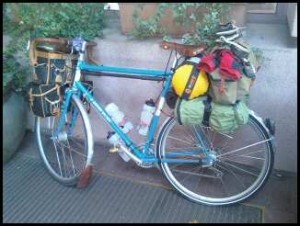

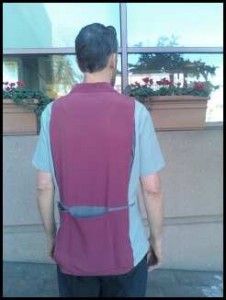
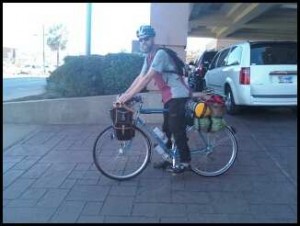
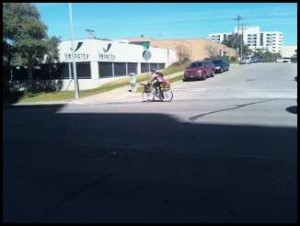
Bike tour on the Southern Tier from Austin, TX to New Orleans, LA in February/March 2011.
While the Bike Hermit is exploring Texas and Louisiana, he is journaling on Crazy Guy on A Bike. Here are a few photos and the link to his Journal





Most of the day yesterday was spent taking apart Chief and putting him in his box for the trip via FedEx to Austin. Even though the thermometer outside struggled to reach 40 degrees, the garage eventually was comfortable thanks to my upgraded heat system.
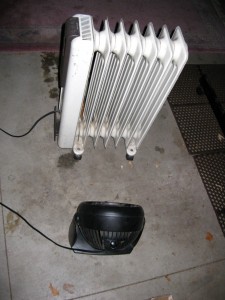
The tools that I am going to carry on the ride are the same tools I used to disassemble the bike. So I am relatively confident that first, I can put the bike back together, and secondly, I can take care of any mechanical issues that might occur.
The Park multi tool has 4,5 and 6 millimeter hex wrenches and phillips and flat blade screwdrivers. And the three sided socket tool has 8, 9 and 10 mm sockets. Every fastener on the bike can be tightened with these two tools. I also carry a spoke wrench and some extra spokes taped to the left chainstay. And since, according to Murphy’s Law, the drive side spokes on the rear wheel will break if any will, I carry a small cassette lockring tool to remove the cassette. There is a small chain tool and an extra chain connecting link. And, of course, tire levers.
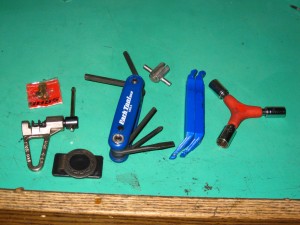
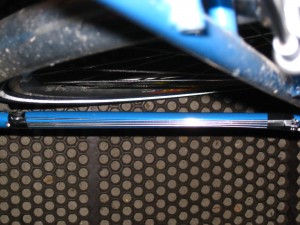
I stuffed as many bicycle bags and as much clothing and miscellaneous items as I could into the box. Overall the weight was about 60 pounds and it cost about $75 to send it to Austin including insurance for $3000. The box is scheduled to arrive in Austin the day after I do. So far, so good!
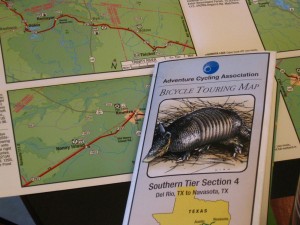
There was new snow on the ground again this morning with more forecast for the rest of the week. I check the forecast for Texas and Louisiana and am pleased to see that temperatures are predicted to be in the 70’s during the day and merely down to the 50’s at night for at least the next week. There is some rain in the forecast and according to the Adventure Cycling map I just got on the mail, Louisiana receives on the average in February and March as much precipitation as this part of Idaho gets in a year. Since my hammock and sleeping pad will travel strapped to the sides of my rear rack I decided I better address the probability of them getting wet.
After brushing the snow off the car we made our way to the Army Navy store where I found some compact and lightweight dry sacks of the perfect size. Since I already have a waterproof compression sack for my sleeping bag, I think I am all set in the riding-in-the-rain department.
The remainder of the afternoon has been spent developing a reasonable schedule so that I could book a hotel room in New Orleans and a flight home. That and reading Sue Gray’s account of her ride on the same part of the Southern Tier earlier this month in some abberantly cold weather. My last two tours have been sort of aggressive from a time allowed standpoint, especially last year, when I did 850 miles in 11 days of riding for an average of 77 miles per day. This year’s route is about 700 miles and I figure I can do it comfortably in 12 days which averages to about 58 miles a day. As an extra cushion I am allowing for one rest day, with zero miles, and one day in New Orleans to get the bike packed and ready to ship back.
We are leaving for Austin on Wednesday. I still need to pack my bike and get it to FedEx tomorrow in order to feel comfortable about it getting there before the end of the week. Stacy flies back home on Tuesday March 1, my first day on the bike.
Dynamo hubs use the rotation of the front wheel to produce electrical current. The bike hermit doesn’t know how they do this. It is an unknowable mystery of the universe. That hasn’t kept him from using Schmidt brand dynamo lighting systems on two of his bikes and one on Sky King’s bike too. When he owned a bike shop he sold and installed many systems also.
Schmidt dynamo hubs and headlights are made in Germany and they are designed to give at least 50,000 trouble free kilometers of service. They are heavier and have more spinning resistance than standard hubs, but the resistance is less than that of other brands of dynamo hubs. The bike hermit requires a reliable source of light that is always available and not dependent on remembering to buy or recharge batteries. Those who know the bike hermit, know why.
The Schmidt E6 halogen primary headlight Chief has carried on previous tours has been joined by a secondary E6. And it looks awesome.
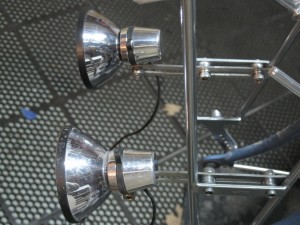
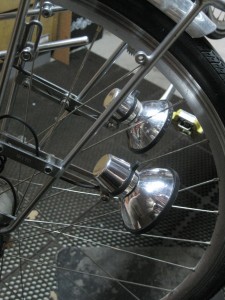
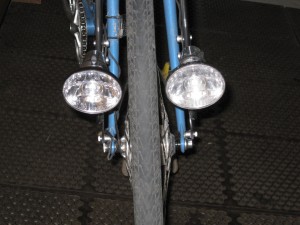
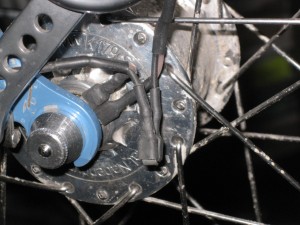
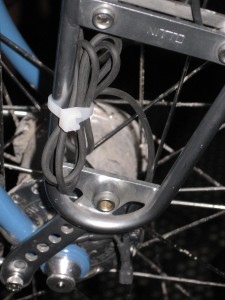
According to the information that came with the secondary light, full brightness of both lights will only be reached at speeds of 16 kph and upwards. Then, by rights, there should be twice the light of one alone. At speeds less than 16 kph, switching off the secondary light will result in the best light output. Which is fine because at lower speeds it is less important to see far ahead and at higher speeds the extra illumination will be nice.
Here is a question for the non electrically challenged. This is a 6 volt system. Each light is 3 watts. Assuming the bike is traveling over 16 kph so that the entire 6 volts is present, switching on the secondary 3 watt light will draw 1/2 amp more in current than the primary light was drawing. Does this mean there will be more resistance in the hub? Will the bike hermit be working harder to light two lights than he was when only one was turned on? The bike hermit’s head is hurting.
The rear light is easier. The bike hermit uses a Spanninga battery powered light mounted to the fender. The AAA batteries for this light are easy to carry and they last for an extremely long time. They are deceptively bright and they don’t have the annoying strobelight, flashing feature, since flashing tail lights are not allowed in Germany. Smart people.
I remember riding through downtown Montreal, Quebec, Canada on my first self supported bike tour with homemade rear panniers which, when the bike hit a rough patch, bounced around and came un-hooked from the rack. Luckily they didn’t fall completely off because the gang of homeless men accosting me from a vacant lot as I rode past would have been happy to relieve me from my load and probably my bike if I had stopped. Needless to say, since that tour I am a little more finicky about my equipment.
On my up-coming tour I am using front and rear racks made by Nitto in Tokyo, Japan. These are made of nickel plated, tubular Chrome-moly steel with simple and solid attachment hardware.
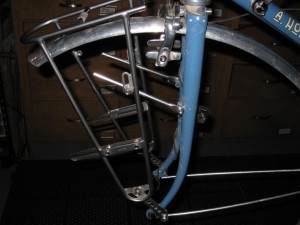
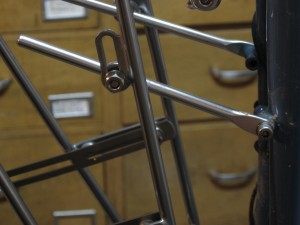
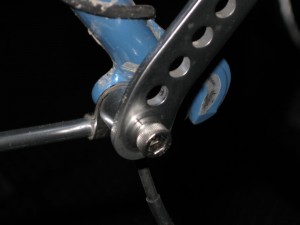
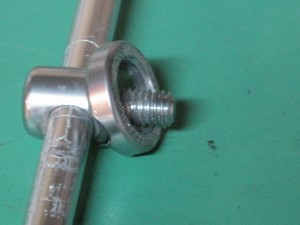
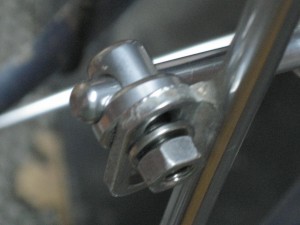
The Nitto Campee front rack comes with detachable low-rider panels for attaching panniers. I have removed those, because I don’t have low rider panniers. The panniers and bags I will be using are the subject of another post. The aluminum struts attaching the rack to the fork eyelets in these photos are sold as separate accessories. The struts which come with the rack are made to attach to cantilever brake posts.
This seems like as good a time as any to look at a couple different fork blade/eyelet/brake combinations. Eyelets are the small, threaded holes drilled into the sides of the fork or into tabs which are then welded onto the dropout (the piece on the end of the fork blade…where the wheel axle attaches). Some bikes have one eyelet on the fork dropout and some have two. There is only one on each dropout on my bike, so the rack and the fender strut clamps will share the same hole. A bike with two dropout eyelets allows a little more flexibility in attaching racks and fenders.
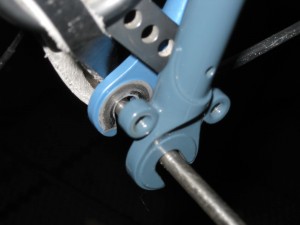
Not all bikes have eyelets on the forks. What? How can that be? Well, some people don’t want to carry stuff on their bikes, believe it or not. For the person who actually uses their bike, however, the more eyelets the better. OK so how about the mid-fork eyelets? On most touring bikes these are located to facilitate “low rider” racks such as the Tubus Tara or the Tubus Duo. And on really well designed touring bikes, like Surly’s Long Haul Trucker, there are two mid-fork eyelets on each fork blade…one on the outside and one on the inside. The Tubus Duo was actually made with that bike in mind. On some bikes, like my Rivendell, the eyelets are located higher on the fork, and these will not work with low-rider only racks. Bikes such as Rivendell, with higher fork mount braze-on eyelets seem to work best with the Nitto type hardware and designs.
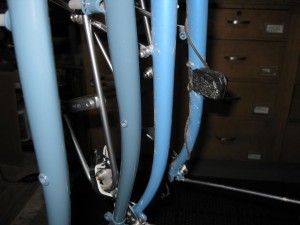
Many touring bikes will also be designed for cantilever style brakes. These brakes are mounted on special posts which are welded on to the fork blades. Some racks like Old Man Mountain brand Cold Springs and Ultimate Low Rider models attach directly to these posts with provided replacement bolts. Others, like some Nitto models attach to these posts with a special, double ended brake bolt or stud.
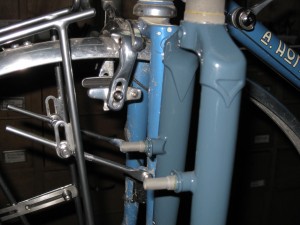
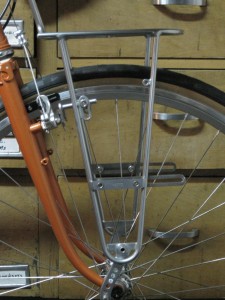
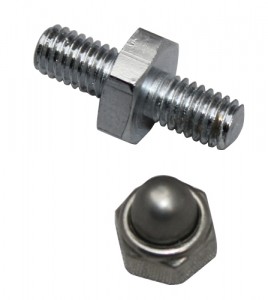
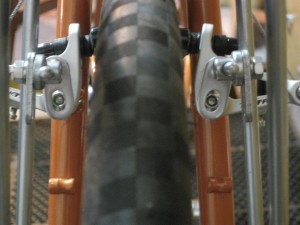
I got a little carried away and off topic with this post, but it felt like a good time to get into some rack details. Hopefully it might give you, good readers, some things on which to cogitate. In the next post I talk about my dual Schmidt E6 headlight setup, about which I am unnaturally excited.
Back when I used to race (and I use that term loosely) my road bike I made it a rule to never do any maintenance on the bike the day before or the day of the race more involved than putting air in the tires. The reason being I always wanted time to do a shakeout ride before race day to make sure everything was working properly. The same rule applies when I go touring.
The chain on my bike was worn, so I replaced it. How do I know it was worn? Because a new chain has a pitch,or distance between links, of exactly 1/2 inch. A quick measurement showed how much my chain had “stretched”
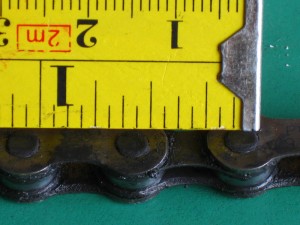
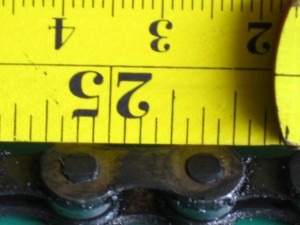
Of course the chain doesn’t actually stretch, the material on the pins and on the links wears away resulting in a new pitch. Over time the teeth on the rear wheel cogs and on the front chainrings will wear to mesh with the new pitch. Then when a new chain is put on, one with a 1/2 inch pitch, it will not lay evenly on the teeth of those other drivetrain components and those will need to be replaced as well or the chain will jump and skip when pedaling. New chains are relatively cheap so I say when in doubt, whip it out.
I will carry a small chain tool with me as well. Chains seldom break, but if they do it could leave me stranded in the middle of nowhere. I will carry the cut off section of a few links from the new chain along with a spare quick link. I’m sure an internet search will reveal a number of videos on how to repair and replace a chain so I will not duplicate that here.
I decided to replace my rear tire as well and take the old one as a spare. The Panaracer T-Serv tire had over 2000 miles of multi surface riding on it and it still has some life in it. I just would rather start out with a fresh tire on this trip. I will be using the Schwalbe Marathon Supreme, my first experience with Schwalbe tires. I will report on that later.
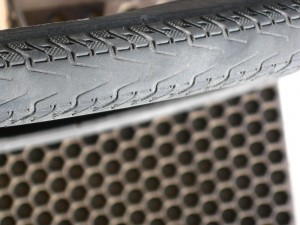
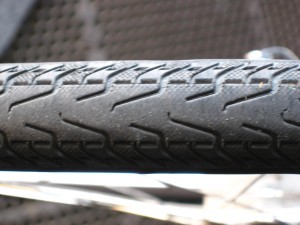
I was a little surprised to see that the Schwalbe tire was a millimeter or so narrower than the Panaracer tires even though both tires are nominally 700 x 32.
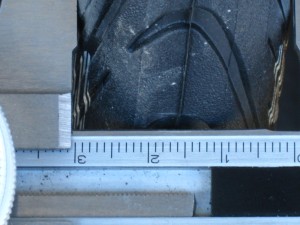
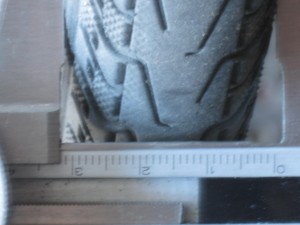
I still need to change my front rack and install the headlights but that’s enough for today.
I leave in one week so I am focusing on those items on the critical path. Items without which the tour cannot be accomplished and which have longer lead times.
Item number one is a box to ship the bike. Rather than a softsided or other airplane friendly case I ordered a re-usable cardboard box like the one I used on the last two tours which is pretty ratty now and besides, I used it to ship a bicycle back to Rivendell last year. I should receive it on Friday. That will leave the weekend to unbuild the bike and pack it so that I can take it to FedEx on Monday. I will send it to the motel in Austin where we are staying. I suppose I could do the same with a conventional, and more durable bicycle case but those all cost more than I want to spend. I can do a dozen tours using 3 or 4 of the cardboard boxes and still be ahead.
Item number next is ordering a map of section 5 of the Southern Tier from Adventure Cycling Association. These maps are so detailed and so refined over the years they have been in use that I get a little nervous when I need to detour from them. It’s also comforting to think of all the other bike tourists who have been along these same routes if only because of the assumption that local motorists might be more aware of bicyclers.
I also plot the route on Google Maps.
View Austin to New Orleans in a larger map
This is not the exact route but for some reason Google Maps would quit letting me make changes after some amount of time or changes.
Since the Southern Tier route only goes to St. Francisville, LA I had to find a way to get through Baton Rouge and into New Orleans. I have been spending some time on the bikeforums.net touring forum and I thought I would put the question to that group. I did a quick search of the forum for routes in New Orleans and was directed to several threads, and I found out about the Mississippi River Trail. From their website:
The Mississippi River Trail, coursing along America’s backbone, the Mississippi River, from its headwaters in Itasca, Minnesota to the Gulf of Mexico, offers approximately 3,000 miles of on-road bikeways and pedestrian and bicycle pathways for the recreational enjoyment, health, conservation and tourism development of river communities, river states, and the nation.
I was able to plot a route, which I’m hoping is pretty decent for cycling, from St. Francisville into New Orleans.
So now I can use my maps to figure out the best places to end up each day. Since I want to go as inexpensively as possible I will be looking for KOA campgrounds and state parks with showers, and I am going to register on the warm showers website to see if I can score some free overnight stays.
“…now the sky is gettin’ light
everything will be alright
I think I finally got the knack
just floatin’ and lazin’ on my back
I never really liked that town
think I’ll ride the river down
just movin’ slow and floatin’ free
this river swingin’ under me
wavin’ back to folks on shore
I should have thought of this before
I’m goin’ on down to New Orleans
pick up on some swingin’ scenes
I know I’ll know a better day
goin’ down groovin’ all the way…”
Micky Dolenz, “Goin’ Down”
Yep, the bike hermit is goin’ on down to New Orleans. Since we are going to be in Austin for the North American Handmade Bicycle Show in February, I started to think about ways to take advantage of being in the south while Idaho emerges from the cold, wet winter months. That thinking has evolved into a bicycle tour from Austin to New Orleans. I will load Chief and journey out on section 5 of the Adventure Cycling Association‘s Southern Tier Route, from Navasota, TX to St. Francisville, LA., and from there down to the Big Easy. Since I am self-absorbed and delusional enough to think people I don’t even know might be interested, I have decided to document my daily planning and preparation tasks, the ride, the trip home and any epilogues.
A simple Google search will uncover a plethora of web pages with itemized lists of what other people take on a bicycle tour , and I think those lists are boring. So I won’t be doing that. Some people have created spreadsheets to plan their itineraries and to document the daily mileage, weather, lodging, food and probably bowel movements. I’m not going to do that either. I want to speak in more general terms about the process of conceiving, planning and executing this bike touring trip as I figure it out. About things that I find out and discover as I explore how to get from here to there by bicycle. The whole concept to me is about freedom. I’m free to ride my bike all day if I want. Indeed, I’m free to ride all night if I feel like it. I’m free to stop whenever and wherever I want. I can go as fast or as slow as I want. All this freedom within limits of course. I do need to complete the ride and come home on the designated day. But everything in between getting on the bike in Austin and getting off in New Orleans is going to unfold as it will. I am literally just along for the ride. And the beer.